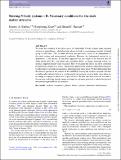Files in this item
Stirring N-body systems - II. Necessary conditions for the dark matter attractor
Item metadata
| dc.contributor.author | Barber, Jeremy A. | |
| dc.contributor.author | Zhao, Hongsheng | |
| dc.contributor.author | Hansen, Steen H. | |
| dc.date.accessioned | 2014-07-24T09:31:07Z | |
| dc.date.available | 2014-07-24T09:31:07Z | |
| dc.date.issued | 2014-05 | |
| dc.identifier | 134770587 | |
| dc.identifier | 60b22afe-eb54-4bba-b434-dfdc7adff1d1 | |
| dc.identifier | 000334742200008 | |
| dc.identifier | 84898962329 | |
| dc.identifier | 000334742200008 | |
| dc.identifier.citation | Barber , J A , Zhao , H & Hansen , S H 2014 , ' Stirring N-body systems - II. Necessary conditions for the dark matter attractor ' , Monthly Notices of the Royal Astronomical Society , vol. 440 , no. 2 , pp. 1044-1051 . https://doi.org/10.1093/mnras/stu407 | en |
| dc.identifier.issn | 0035-8711 | |
| dc.identifier.uri | https://hdl.handle.net/10023/5070 | |
| dc.description | This work is supported in part by the Science and Technology Facilities Council. | en |
| dc.description.abstract | We study the evolution of the phase space of collisionless N-body systems under repeated stirrings or perturbations, which has been shown to lead to a convergence towards a limited group of end states. This so-called attractor was previously shown to be independent of the initial system and environmental conditions. However, the fundamental reason for its appearance is still unclear. It has been suggested that the origin of the attractor may be either radial infall (RI), the radial orbit instability (ROI), or energy exchange which, for instance, happens during violent relaxation. Here, we examine the effects of a set of controlled perturbations, referred to as 'kicks', which act in addition to the standard collisionless dynamics by allowing pre-specified instantaneous perturbations in phase space. We first demonstrate that the attractor persists in the absence of RI and ROI by forcing the system to expand. We then consider radial velocity kicks in a rigid potential and isotropic velocity kicks, since there are no energy exchanges in these two recipes of kicks. We find that these kicks do not lead to the attractor, indicating that the energy exchange in a dynamic potential is indeed the physical mechanism responsible for the attractor. | |
| dc.format.extent | 8 | |
| dc.format.extent | 1073337 | |
| dc.language.iso | eng | |
| dc.relation.ispartof | Monthly Notices of the Royal Astronomical Society | en |
| dc.subject | Methods: numerical | en |
| dc.subject | Galaxies: haloes | en |
| dc.subject | Galaxies: kinematics and dynamics | en |
| dc.subject | Radial orbit instability | en |
| dc.subject | Space density profiles | en |
| dc.subject | Halos | en |
| dc.subject | Universal | en |
| dc.subject | Slope | en |
| dc.subject | Mergers | en |
| dc.subject | QB Astronomy | en |
| dc.subject.lcc | QB | en |
| dc.title | Stirring N-body systems - II. Necessary conditions for the dark matter attractor | en |
| dc.type | Journal article | en |
| dc.contributor.sponsor | Science & Technology Facilities Council | en |
| dc.contributor.institution | University of St Andrews. School of Physics and Astronomy | en |
| dc.identifier.doi | 10.1093/mnras/stu407 | |
| dc.description.status | Peer reviewed | en |
| dc.identifier.grantnumber | PP/F000065/1 | en |
This item appears in the following Collection(s)
Items in the St Andrews Research Repository are protected by copyright, with all rights reserved, unless otherwise indicated.

